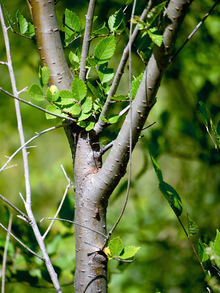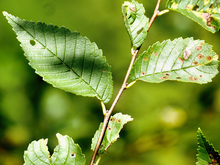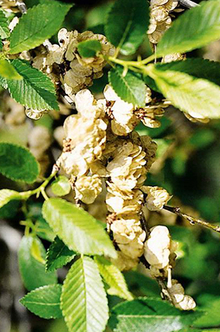Quick facts
Siberian elm is an invasive species.
- Siberian elm is able to move into and quickly dominate disturbed prairies in just a few years.
- It grows in areas with poor soils and low moisture.
- Seed germination is high and it establishes quickly on sparsely vegetated soils.
- It can cross pollinate with native elms, making identification difficult.
- It is resistant to Dutch Elm disease.
How to identify Siberian elm
- Deciduous tree, 30 to 70 feet high with an open, rounded crown and slender, spreading branches.
Stem
- Bark is dark gray and shallowly furrowed on mature tree.
Branches
- Thin, delicate-looking, silver-gray twigs have a zig-zag shape with a leaf bud at each turn.
Leaves
- Alternate, small, 1–2 inches, elliptic, toothed, short-pointed tips and slightly uneven at the base.
- Distinctly smaller size and much less uneven leaf base than American elm.
Flowers
- Greenish, lacking petals and occurring in small, compact, drooping clusters of 2 to 5.
- Appear before leaves develop.
Fruit and seeds
- Winged, round, smooth fruit hangs in clusters.
- Contains one seed.
- Can be a prolific seed producer.
Roots
- Extensive, shallow.
Reviewed in 2019




